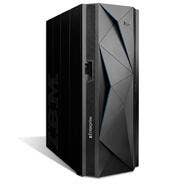IBM Intros Entry Mainframe With New zBC12

IBM on Tuesday unveiled its latest mainframe, a model that, with a starting price of only $75,000, can actually be lower in cost to operate than a distributed x86-based server infrastructure, the company said.
IBM's new zEnterprise BC12, or zBC12, is a follow-on to the IBM z114 midrange mainframe and is targeted at such applications as data analytics, cloud computing, and Linux.
The zBC12 offers similar capabilities as the IBM zEC12, including the Integrated Facility for Linux (IFL) engine for running Linux applications, and the System z Application Assist Processor (zAAP) and System z Integrated Information Process (zIIP) for accelerating workload processing.
[Related: Q1 Server Business Plummets: Key Findings From IDC ]
However, the zBC12 has a maximum memory of 496 GB compared to the zEC12's max of 3 TB, and it has more limited connectivity options.
Mainframes continue to be a consistently good business for IBM. Last week, during IBM's second-quarter 2013 financial call, IBM said sales of its System z mainframes rose 10 percent compared to the same period of 2012, making it the only part of IBM's server business to actually see a revenue increase.
The mainframe has also proven to be a strong business for solution providers, said Kurt Repholz, vice president of System z sales for Mainline Information Systems, a Tallahassee, Fla.-based solution provider and IBM partner.
Repholz, who has been working with mainframes for the last 13 years, said mainframes offer big benefits to Mainline customers in the mobile computing and data analytics markets.
"Customers have more and more apps that offer mobile access," Repholz said. "Especially banking apps. Most big banks use mainframes for mobile apps. They are the best for serving high-frequency transactions, and they are more secure than other server platforms."
While a starting price of $75,000, or monthly lease of $1,965, gives a pretty basic configuration, it makes the xBC12 mainframe attractive to many customers, including those running a lot of Linux applications, because of their low total cost of ownership, Repholz said.
"It's not just the cost of the hardware, but also the software, implementation and personnel that keeps costs down," he said. "In a distributed environment, the System z is often the least-expensive option. For example, if requirements grow, System z customers don't need to buy new servers. They can increase the capabilities of their existing servers on-the-fly."
While mainframes are often criticized as requiring specialized skills, Repholz said that is not really an issue.
"Colleges and universities have curriculums for the new workloads," he said. "We're seeing a lot of younger people coming in as IT directors or data center managers with these skills."
PUBLISHED JULY 23, 2013